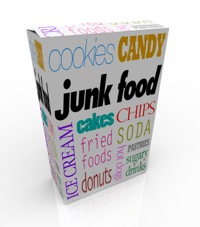Guest Blogger: Pilar Cobb, owner bFit Studio
FACT: If a food is in your possession or located in your residence, you will eventually eat it.
 If you wish to be healthy and lean, revolutionize your kitchen with a different kind of kitchen makeover — remove all foods not conducive to health and leanness from your house and replace them with a variety of better, healthier food choices.
If you wish to be healthy and lean, revolutionize your kitchen with a different kind of kitchen makeover — remove all foods not conducive to health and leanness from your house and replace them with a variety of better, healthier food choices.
Think of all the siren calls that confront you, every day, outside your home. Make no mistake about it; your willpower and discipline are constantly tested. Chips and dip at social events. Brownies and birthday cakes at work. Pizza and hot dogs at the game. And just to pour salt on your dietary wounds, you probably pass a Krispy Kreme or Dunkin Donuts on your way to, anywhere.
With all this temptation, you need to have a safe home base. Where the temptations don’t exist. So why not make your safe base your home?
Now, some people might argue that developing a good nutritional lifestyle means developing the will power to say no to these types of foods even if the foods are in their midst. Instead of avoiding these foods, they should control the impulse to eat these foods.
This is definitely an interesting perspective. And internal control is critical. However, this takes time to develop. And until it does, the only way to avoid the foods you know you shouldn’t be eating is to simply avoid the external temptation.
But even when the internal control has built up, it’s still best to avoid tempting yourself often. After all, no one brings alcohol to AA meetings as a means to improve the attendee’s self-discipline. Likewise, you shouldn’t try to “test” your willpower with trigger foods at home.
So let’s get started with the fridge, shall we?
THE FRIDGE
Depending on the state of your fridge, you might want to invest in some of those triple-ply trash bags that can hold a lot of weight. That’s right, it’s cleanin’ time! Let’s make some room for the good stuff you need to stock in the fridge.
Here’s what to throw away:
Instead of dedicating an entire section of things that should not be in your fridge, these are a few common no-no’s that have no business being in your safe place.
Again, it’s not that these foods should never be eaten. After all, the occasional treat is recommended. It’s just about these foods should be minimized.
Soft drinks and fruit juices. Calorie-containing drinks are one of the biggest contributors to climbing obesity rates in the Western world. But it’s not just the soda that’s the problem. Think that cranberry cocktail is healthy? Think again, sugar is second only to water in the ingredients. Replace with water or zero calorie drinks.
Mayonnaise and most commercially available high fat dips/dressings. Mayo and other high fat dips usually contain in the neighborhood of 60+% oil by weight. The problem is that poor choices of oil are used. Replace with healthy fats such as olive oil, nuts and avocados.
Sour cream and other fatty dairy products. Full fat dairy products are composed primarily of saturated fat. The exception we make is butter, which is more stable at high cooking temperatures than olive oil. Again, these foods are not evil and can be used in moderation. But keep in mind that it’s very easy to “sneak calories” in when stocking high fat dairy in the house. Use Greek Yogurt in place of sour cream. It also increases your protein intake.
High fat processed meat. Many types of sausage, bacon, and related products are loaded with undesirable types of fat, tons of sodium, and even carbohydrates. These are 8 grams of fat per ounce and about 100 calories. Replace with lean proteins that are 3 grams of fat or less and 35 calories per ounce.
Frozen desserts and ice cream. Even the low fat frozen desserts are sugar bombs waiting to sabotage your physique. Keep an eye on labels. It is common that manufacturers sneak sugars in everywhere. Enough said!
 Sugar and oil laden sauces and dressings. Nothing can ruin a great, healthy meal more quickly than a high sugar sauce or dressing. Many bottled sauces are nothing more than spiced high fructose corn syrup (BBQ sauce, ketchup, marinade). Try making your own and use low calorie sweetener. Also, use all dressings on the side so you can control the portions.
Sugar and oil laden sauces and dressings. Nothing can ruin a great, healthy meal more quickly than a high sugar sauce or dressing. Many bottled sauces are nothing more than spiced high fructose corn syrup (BBQ sauce, ketchup, marinade). Try making your own and use low calorie sweetener. Also, use all dressings on the side so you can control the portions.
There are, of course, some sauces that can be incorporated into a healthy diet, such as salsa, low-sugar marinades. Instead of stocking the fridge with all the sauces and dressings, stock it with different vinegars and healthy oils (flax and olive) as well as veggies that can be turned into healthy salsas or dips.
Most processed foods. Forget processed foods packaged in colorful wrappers, boxes, bags, or containers. Be wary of such foods: the “healthiness” of a food generally declines in proportion to its degree of processing – even when “health” claims are made on the label.
A short list of processed food include: snack foods like chips, cookies, cakes, etc), frozen foods like “TV dinners”, fish sticks, waffles, instant foods like mac and cheese, instant mashed potatoes, instant pancake mix, whitened foods like breads, white rice and pasta, deli foods like lunch meat, boxed sugared cereals……and more.
Here is what to keep
Your goal should be to try to gets as close to original, whole food as possible. A good way to think this is that if the food is separated from its original source by more than 3 steps, minimize its contribution to your diet. For example:
- Broccoli: grows in the ground; 1 step; excellent.
- Chicken breast: protein from a chicken; injected with water; 2 steps; excellent
- Whole grains: grown in the ground; ground; 2 steps; excellent
- Chili Mac: pasta (ground grain, bran removed), high fat composite meat, tomato concentrate, spices; 7 or more steps; poor.
Pilar Cobb, NASM/ACE Certified Personal Trainer
Certified Fitness Nutrition Specialist
Owner, bFit Studio
www.bfitcolumbus.com
Image Source: Graphicleftovers.com


